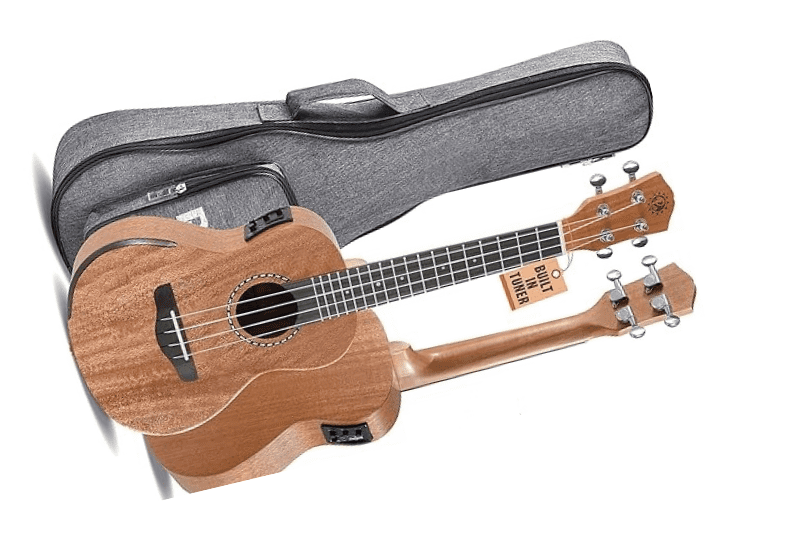Best Electric Ukuleles for Pros

Introduction
Electric ukuleles have witnessed a surge in popularity among professional musicians, offering enhanced versatility and performance capabilities. This comprehensive guide delves into the critical factors that define the best electric ukuleles for professionals, highlighting key considerations for selecting the optimal instrument.
Overview of Electric Ukuleles’ Popularity
The evolution from acoustic to electric ukuleles mirrors a broader trend in music towards amplified instruments. Professionals increasingly favor electric ukuleles for their ability to project sound effectively in diverse musical settings, from intimate studio recordings to large concert venues.
Importance of Choosing the Right Electric Ukulele
Selecting suitable Professional Electric Ukuleles is pivotal for professional musicians aiming to achieve superior sound quality and adaptability across various musical genres. Factors such as build quality, sound enhancement features, and ergonomic design significantly impact the instrument’s performance and user experience.
Understanding Electric Ukuleles
Definition and Evolution
Electric ukuleles are stringed instruments equipped with electronic components to amplify sound. Originating from acoustic models, their evolution includes advancements in pickup technology and materials, enhancing sound projection and tonal clarity in modern music production.
Advantages Over Acoustic Models
Professional Electric Ukuleles excels in amplified sound projection and tonal versatility, surpassing their acoustic counterparts in live performance and studio recording environments. They integrate seamlessly with amplifiers and effects pedals, offering musicians greater control over their sound dynamics.
Features to Consider
Build Quality of Professional Electric Ukuleles
The durability and resonance of electric ukuleles hinge on superior craftsmanship and high-quality materials. Instruments crafted from solid woods, carbon fiber, or high-grade plastics ensure robust performance, sustaining optimal sound clarity and integrity under varying environmental conditions.
- Materials Impacting Durability: Solid woods and carbon fiber enhance instrument longevity.
- Craftsmanship Standards: Precision in construction influences playability and resonance.
- Environmental Resilience: Materials resistant to humidity and temperature changes prolong instrument lifespan.
Sound Enhancement Features
Critical components such as onboard pickups (e.g., piezo, magnetic) and EQ controls shape the ukulele’s tonal characteristics. Advanced preamp systems minimize noise interference and facilitate precise tone adjustments, crucial for achieving optimal sound fidelity in professional applications.
- Pickup Technology: Piezo pickups for natural acoustic tones, magnetic pickups for enhanced sustain.
- EQ Controls: Parametric EQs allow fine-tuning of frequencies, adapting to various musical styles.
- Preamp Quality: High-quality preamps reduce noise and maintain signal integrity in performance settings.
Unique Designs and Aesthetics
Ergonomic considerations such as body shape, neck profile, and fretboard design optimize playability and comfort during extended performances. Aesthetic elements including finishes, inlays, and ergonomic contours not only enhance visual appeal but also reflect personal style preferences on stage.
- Ergonomic Design: Comfortable neck profiles and balanced weight distribution reduce fatigue.
- Visual Appeal: Custom finishes and artistic inlays complement stage presence and personal expression.
- Practical Ergonomics: Body contours and fretboard radius enhance ease of play for professional musicians.
Review of Top Models
Cordoba Electric Ukuleles
Construction and Tonewoods
This model is known for its balanced tonal profile and durability. Crafted with precision, it delivers clear articulation and sustain, ideal for professional musicians seeking reliability and versatility in sound production.
- Construction Precision: Handcrafted details ensure consistent quality and playability.
- Sound Versatility: Suitable for genres requiring nuanced tonal expression and dynamic range.

User Feedback
Musicians praise its responsiveness and playability across diverse musical genres, citing its ability to deliver consistent performance in both live and studio settings. User testimonials underscore its reliability and adaptability, making it a preferred choice among professionals worldwide.
Kmise Electric Ukuleles
Innovative Features
This model integrates cutting-edge design innovations with robust construction. While celebrated for its strengths, user feedback highlights considerations such as limitations or improvements needed in demanding professional environments.
- Innovative Technology: Enhances sound projection and tonal versatility.
- Performance Reliability: User-tested under rigorous conditions for durability and sound fidelity.
- Professional Endorsements: Preferred by musicians for its innovation and performance reliability.

Performance Insights
Professionals commend its balanced sound quality and ergonomic design, contributing to enhanced playability during extended performances. Its intuitive controls and versatile sound options make it an invaluable asset for musicians exploring diverse musical genres and creative expressions.
Pyle Electric Ukuleles
User-Friendly Design
Engineered for intuitive operation, this model features ergonomic enhancements and user-centric design elements. Its adaptability caters to professional musicians seeking reliability and ease of use in live performances and studio recordings.
- User-Centric Features: Intuitive controls and ergonomic design promote comfort and ease of play.
- Technological Advancements: Enhances performance versatility.
- Genre Suitability: Ideal for genres requiring dynamic tonal range and precise sound articulation.

Technological Advancements
Advanced features such as [specific technology] elevate its performance capabilities, ensuring optimal sound quality and user satisfaction in professional applications. Its seamless integration with studio equipment and live performance setups underscores its value in modern music production.
Expert Insights and Testimonials
Insights from Industry Experts
Renowned musicians and luthiers emphasize critical factors in electric ukulele selection, including tonal clarity, ergonomic design, and build quality. Their insights guide professionals in choosing instruments tailored to specific performance requirements and creative preferences.
- Expert Recommendations: Insights on selecting instruments for studio recording and live performances.
- Performance Standards: Criteria for evaluating sound fidelity, durability, and ergonomic comfort.
- Creative Applications:Advice on integrating electric ukuleles into diverse musical genres and performance contexts.
Real-Life Testimonials
Anecdotal accounts from professional ukulele players highlight their preferred models and performance experiences in real-world settings. Case studies illustrate the instrument’s adaptability and reliability, offering practical guidance for prospective buyers seeking professional-grade instruments.
- Performance Challenges: Real-life scenarios demonstrating instrument capabilities and limitations.
- User Experiences: Feedback on sound quality, playability, and durability under professional demands.
- Long-term Reliability: Insights into instrument longevity and maintenance practices for sustained performance excellence.
Buying Guide for Professional Electric Ukuleles
Factors to Consider When Choosing
A comprehensive checklist guides musicians in evaluating scale length, string gauge, and fretboard preferences aligned with professional performance needs. Instrument weight, balance, and portability considerations ensure comfort and mobility during extended playing sessions.
- Performance Criteria: Scale length and string gauge impacts tonal range and playability.
- Ergonomic Features: Neck profile and fretboard radius influence comfort and ease of play.
- Portability Requirements: Lightweight designs for gigging musicians requiring mobility and durability.
Budget Considerations
An analysis of price categories (entry-level, mid-range, premium) helps musicians align budget constraints with desired features and performance expectations. Value assessments based on durability, sound quality, and included accessories inform purchasing decisions for professional-grade instruments.
- Budget Allocation: Investment strategies for balancing instrument quality and financial constraints.
- Feature Prioritization: Considerations for essential features versus optional upgrades in professional settings.
- Long-term Value: Cost-benefit analysis of instrument durability and maintenance costs over time.
Performance and Genre Suitability
Matching instrument capabilities with specific musical genres involves evaluating dynamic range, tonal clarity, and sustain for optimal performance outcomes. Instruments tailored to [specific genres] ensure versatility and reliability in diverse musical contexts, accommodating professional requirements for expressive creativity.
- Genre-specific Requirements: Sound characteristics and performance dynamics tailored to musical genres.
- Performance Expectations: Criteria for assessing tonal versatility and sound articulation in live and studio environments.
- Creative Flexibility: Instrument adaptability for exploring new musical genres and experimental compositions.
Maintenance and Care Tips
Essential Maintenance Practices
Routine maintenance routines such as cleaning, string replacement, and humidity control sustain instrument performance and longevity. Regular inspections for fret wear, electronic connections, and hardware adjustments ensure consistent sound quality and operational reliability.
- Maintenance Schedule: Step-by-step guidelines for maintaining instrument integrity and functionality.
- Environmental Considerations: Humidity and temperature controls for preserving tonal quality and wood integrity.
- Technical Support: Troubleshooting tips for addressing common issues and optimizing instrument performance.
Troubleshooting Common Issues
Identification and resolution of electronic malfunctions, fret buzz, and intonation problems equip musicians with essential troubleshooting skills. Techniques for addressing minor adjustments and optimizing sound settings support uninterrupted performance quality in professional settings.
- Diagnostic Procedures: Methods for identifying and resolving electronic and mechanical issues.
- Performance Optimization: Adjusting instrument settings for optimal sound projection and tonal balance.
- Emergency Preparedness: Backup strategies and technical support resources for maintaining performance continuity.
Conclusion
Choosing the best electric ukulele for professional use requires careful consideration of build quality, sound enhancement features, and ergonomic design. By leveraging expert insights, real-life testimonials, and a comprehensive buying guide, musicians can confidently select instruments that enhance their creative expression and performance versatility. Electric ukuleles empower professionals to explore diverse musical landscapes, shaping the future of modern music composition and live performance excellence.

